The Story of the Churning of the Ocean
Reading Time: 10 min
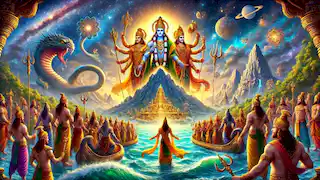
About Story: The Story of the Churning of the Ocean is a Myth from india set in the Ancient. This Dramatic tale explores themes of Good vs. Evil and is suitable for All Ages. It offers Cultural insights. A timeless myth of gods, demons, and the search for immortality in the cosmic ocean.
{{{_intro}}}
In the ancient days, when the world was still young, the forces of good and evil waged a never-ending battle. The Devas, or gods, were the embodiments of righteousness, order, and light, whereas the Asuras, their eternal rivals, represented chaos, darkness, and destruction. Both groups were mighty, but neither had the upper hand for long. At the core of their struggle lay a secret desire shared by both: the Amrita, the nectar of immortality. If either side were to drink this elixir, they would become invincible, able to rule the universe for all eternity.
The Amrita, however, was not easily obtainable. It lay hidden deep within the vast cosmic ocean, the Kshira Sagara, an endless body of milk that spanned the universe. This ocean was not a place where mortals or even gods could swim or sail. It was a primordial, metaphysical realm, where the laws of time and space were bent, and only the bravest or the most foolish would dare venture.
Desperate to secure their power, the Devas, under the guidance of their king Indra, sought counsel from the great preserver of the universe, Lord Vishnu. Vishnu, known for his wisdom and his ability to maintain balance in the cosmos, devised a plan. It was one of collaboration, for only through cooperation could the Amrita be retrieved from the depths of the ocean. Vishnu’s proposal was bold: the Devas and Asuras, though enemies, would have to work together to churn the ocean and bring forth the treasures hidden within, including the nectar of immortality. The Devas, though skeptical about trusting the Asuras, knew they had little choice. Their strength had been waning after many battles, and without the Amrita, they could soon face extinction. The Asuras, cunning and ambitious, saw an opportunity. Though suspicious of the Devas' motives, they believed that by working together, they could outmaneuver the gods and claim the nectar for themselves. After much deliberation, both sides agreed to the plan. The first challenge was to find a suitable churning rod—something massive and stable enough to churn the ocean. Vishnu suggested using Mount Mandara, an enormous and sacred mountain whose height reached the heavens, and whose roots touched the underworld. This mountain was heavy, solid, and perfect for the task, but it was far too massive for either the Devas or the Asuras to lift alone. To transport the mountain to the ocean, the Devas and Asuras sought help from Garuda, the king of birds and Vishnu’s celestial mount. With his mighty wings, Garuda carried Mount Mandara across the sky and placed it at the center of the cosmic ocean. Now that the churning rod was in place, the gods and demons needed a suitable rope to rotate the mountain. Lord Vishnu suggested Vasuki, the king of serpents, whose body was large enough to encircle the mountain and be used as a rope. Vasuki, although reluctant, agreed to be a part of the great endeavor. The Devas and Asuras, ready for the monumental task ahead, prepared to begin the churning. There was one final decision to be made: who would hold which part of the serpent? The Devas, led by Indra, convinced the Asuras to take hold of Vasuki’s head, while the Devas would hold the tail. The Asuras, unaware of the gods' cunning, agreed to this arrangement. What they did not realize was that Vasuki, being a serpent, would exhale deadly fumes from his mouth as the churning began. These toxic fumes would weaken the Asuras, giving the Devas an advantage in the long run. With the Devas at the tail and the Asuras at the head, the churning began in earnest. They pulled Vasuki back and forth, causing Mount Mandara to rotate in the ocean, stirring its depths. But soon after they began, the weight of the mountain became too much for the ocean to support, and Mount Mandara began to sink. Seeing the mountain descend into the ocean, the Devas and Asuras were filled with despair. The entire plan seemed doomed to fail before it had even begun. But once again, Lord Vishnu came to the rescue. Realizing that the mountain needed a solid foundation to keep it afloat, he decided to take on a new form. Vishnu transformed into Kurma, a gigantic tortoise with a shell as vast as the earth itself. Kurma dove into the depths of the ocean and lifted Mount Mandara on his back, providing the stability needed for the churning to continue. With Vishnu’s steady support, the gods and demons resumed their efforts, pulling the serpent Vasuki back and forth with renewed vigor. As the churning progressed, the ocean began to reveal its hidden treasures. But the first thing to emerge was not a treasure but a deadly poison known as Halahala. This poison was so potent that its mere presence threatened to destroy the entire universe. The Devas and Asuras recoiled in horror, unsure of how to deal with such a catastrophic force. In their desperation, they turned to Lord Shiva, the god of destruction and transformation. Shiva, known for his immense power and control over destructive forces, agreed to help. He took the Halahala in his hands and, without hesitation, drank the poison to save the universe. But the poison was so deadly that it began to burn Shiva from within. To prevent the poison from spreading through his body, his wife, Parvati, quickly intervened. She placed her hand on his throat, stopping the poison from descending further. As a result, Shiva’s throat turned blue, but the rest of his body remained unharmed. From that day onward, Shiva became known as Neelkantha, "the one with the blue throat," a reminder of his great sacrifice for the universe. With the poison neutralized, the churning continued, and soon the ocean began to yield more treasures, each more wondrous than the last. These divine treasures were known as Ratnas, and their emergence marked significant moments in the cosmic balance of power. Among the treasures that surfaced from the ocean were: 1. Kamadhenu, the celestial cow, which could grant any wish and provide endless nourishment. 2. Airavata, the magnificent white elephant, which would later become the mount of Indra, the king of the Devas. 3. Uchchaihshravas, a divine horse with seven heads, known for its speed and strength. 4. Kaustubha, a resplendent jewel of unparalleled beauty, which Vishnu claimed for himself and wore on his chest. 5. Apsaras, celestial maidens of exquisite beauty, who became the entertainers of the gods. 6. Kalpavriksha, the wish-fulfilling tree, which would grant any desire to those who sought its blessings. Each of these treasures found its place among the gods or demons, with both sides benefiting from the fruits of their labor. The ocean continued to churn, but the ultimate prize—the Amrita—remained elusive. After what seemed like an eternity of churning, the final and most coveted prize began to emerge from the depths of the ocean. Dhanvantari, the divine physician, rose from the waters, holding in his hands a shining pot of Amrita, the nectar of immortality. The sight of the precious nectar immediately ignited a fierce desire in both the Devas and the Asuras, for they knew that whoever drank the nectar would become immortal. As soon as Dhanvantari emerged, a fierce battle broke out between the Devas and the Asuras. The Asuras, using their superior strength, managed to seize the pot of Amrita from Dhanvantari’s hands. But their victory was short-lived, for Lord Vishnu had anticipated this moment and was ready with a plan to ensure that the nectar did not fall into the wrong hands. Vishnu, ever the master strategist, decided to use the Asuras' greed and arrogance against them. He transformed into Mohini, a celestial maiden of incomparable beauty and grace. Mohini’s allure was so overwhelming that the Asuras, who had been on the brink of war with the Devas, were instantly entranced by her. In their foolishness, they handed the pot of Amrita to Mohini, trusting her to distribute it fairly among both groups. However, Mohini had no intention of giving the nectar to the Asuras. She began to serve the Amrita to the Devas, one by one, ensuring that they all received their share of the nectar while none of it reached the Asuras. As Mohini continued to distribute the nectar to the Devas, one of the Asuras, Rahu, grew suspicious of her intentions. Disguising himself as a Deva, Rahu slipped into the line and managed to take a sip of the Amrita. However, before the nectar could fully take effect, the sun god Surya and the moon god Chandra recognized Rahu and alerted Lord Vishnu. In an instant, Vishnu hurled his Sudarshana Chakra, his divine discus, and severed Rahu’s head from his body. But because Rahu had already consumed the nectar, he became immortal. From that moment on, Rahu’s head continued to exist as a separate entity, while his body was replaced by another entity known as Ketu. Together, Rahu and Ketu became the cosmic forces responsible for eclipses, as they eternally chased the sun and the moon, seeking revenge for their betrayal. With the Asuras thwarted and the Amrita safely in their hands, the Devas rejoiced. They had achieved what they had set out to do: secure their immortality and preserve the balance of the universe. Each of the Devas drank the nectar, and their powers were restored, allowing them to continue their eternal duty as the protectors of the cosmos. The Asuras, meanwhile, were left humiliated and defeated. Though they had come close to seizing the nectar, their greed and arrogance had been their undoing. They returned to their realms, vowing revenge but knowing that the balance of power had shifted in favor of the Devas. The Samudra Manthan, or the Churning of the Ocean, is more than just a story of gods and demons battling for supremacy. It is a timeless allegory about the forces of creation and destruction, cooperation and conflict, and the eternal struggle between good and evil. The treasures that emerged from the ocean represent the fruits of perseverance, while the poison Halahala symbolizes the dangers and sacrifices that often accompany great endeavors. The churning of the ocean teaches us that even the most difficult challenges can be overcome with wisdom, patience, and unity. At its heart, the story is a reminder that balance must be maintained in the universe, and that both light and darkness, creation and destruction, have their roles to play in the grand cosmic order.The Beginning of the Churning
The Clever Deception of the Gods
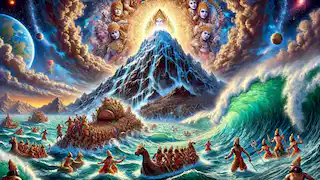
Vishnu’s Tortoise Avatar: Kurma
The Emergence of Halahala: The Deadly Poison
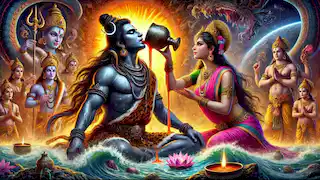
The Divine Treasures
The Emergence of Dhanvantari
Vishnu’s Deception: The Mohini Avatar
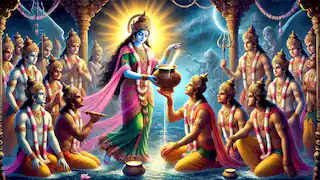
Rahu and Ketu: The Guardians of Eclipses
The Triumph of the Devas
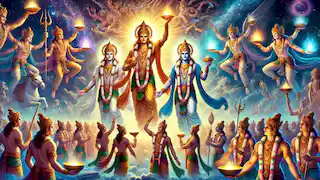
The Enduring Legacy of Samudra Manthan

















